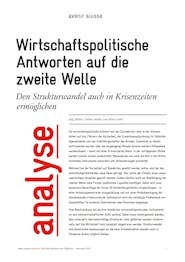So far the economic response to the coronavirus has rested on three pillars: short-time working, the income replacement scheme for self-employed people, and federal loan guarantees. All these mechanisms are based on established institutions and are designed for a broad impact. In the first wave they were adapted rapidly and unbureaucratically to the extraordinary situation. But in the heat of the moment, mistakes were also made. The measures have certain disadvantages that are becoming particularly apparent as time goes on. For this reason, Avenir Suisse recommends making targeted improvements to the existing mechanisms rather than distorting the process of economic adjustment with new contributions with no payback requirement.
Overhaul labor market mechanisms…
Merely extending loss of earnings support for self-employed people oversimplifies the matter. To give the self-employed easier access to liquidity a new, two-tier approach should be looked into. People running their own business owners who have private pension capital could be allowed to make an advance withdrawal of their retirement assets, while those on a low income could be paid reduced loss of earnings linked to the decline in their turnover.
This solution, which would be temporarily subject to clear time limits, would enable self-employed people who earned well in earlier years to bridge the liquidity gap from their own funds. At the same time it would prevent self-employed people who had previously earned enough to be financially self-sufficient but not enough to put aside reserves from having to rely on social security during the coronavirus pandemic.
While new ideas are needed for the self-employed, the tried-and-tested approach to short-time working should be retained. Implementation, eligibility, and waiting periods for short-time working should be normalized again rapidly. The longer the federal government relies on exceptional arrangements, the greater the damage to the economy will be. The special facilities currently on offer impede processes of economic transformation, with delays in necessary structural change that will cost billions.
…and set up a modified Covid-19 loan scheme
As they did in the first wave, many companies are likely to need additional liquidity during the second. For this reason, Avenir Suisse proposes a temporary repeat of the Covid-19 solidarity guarantees. Payments without a payback requirement are the wrong way to go, leading to political intervention in private-sector activity. Instead of the government subsidizing individual companies in the form of hardship aid, a loan scheme would have a broad impact and lead to less economic distortion.
However, if the scheme is relaunched, the banks should be required to bear part of the risk themselves, meaning they would have to conduct the customary in-depth check on applicants’ creditworthiness. A close look at the guarantees granted in the first wave reveals that early in the year a lot of money went to companies that had already been on the brink of bankruptcy before the pandemic. A new edition of the guarantee scheme should also happen on a competitively neutral basis, with financial institutions other than banks also able to participate.
No new and politically motivated aid programs
Avenir Suisse’s latest analysis also describes the problems involved in the special assistance for individual companies and industries currently foreseen by the federal government for the second wave. This type of state intervention often results in unequal treatment. Not only that, but assistance of this sort has to drafted completely anew under time pressure, and inserted into laws and regulations. The risk of inconsistencies and errors is high, and there is also the possibility of overcompensation – as has already been seen, for example, in the field of culture and the arts.
Politicians would do well to limit themselves to the three proven economic policy mechanisms. The adaptations proposed by Avenir Suisse will help a middle way to be found for the second wave: no wanton endangerment of viable structures, but no complete freeze of the economy either. Even in a pandemic, there has to be scope for structural change and dynamic adjustments to the new crisis situation.







